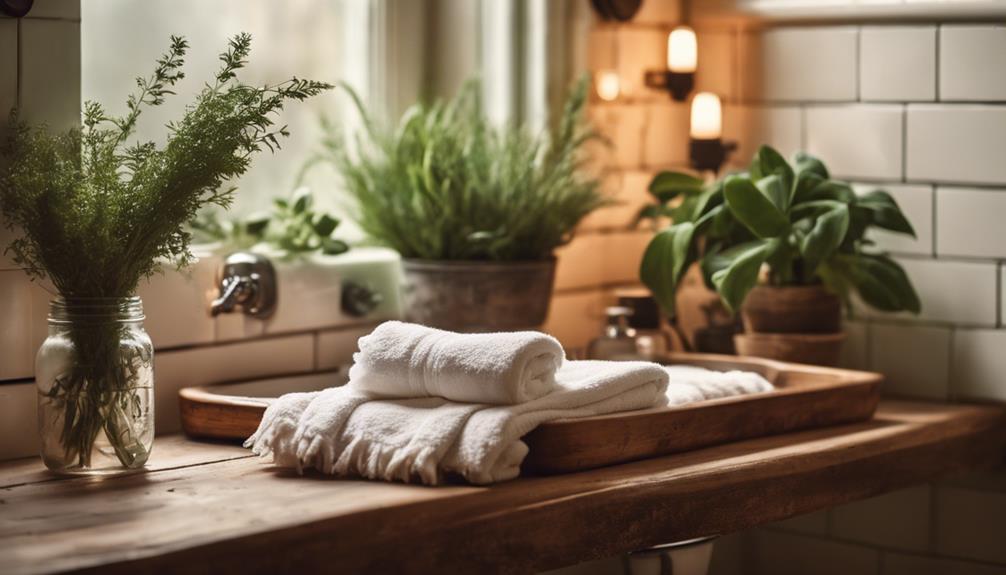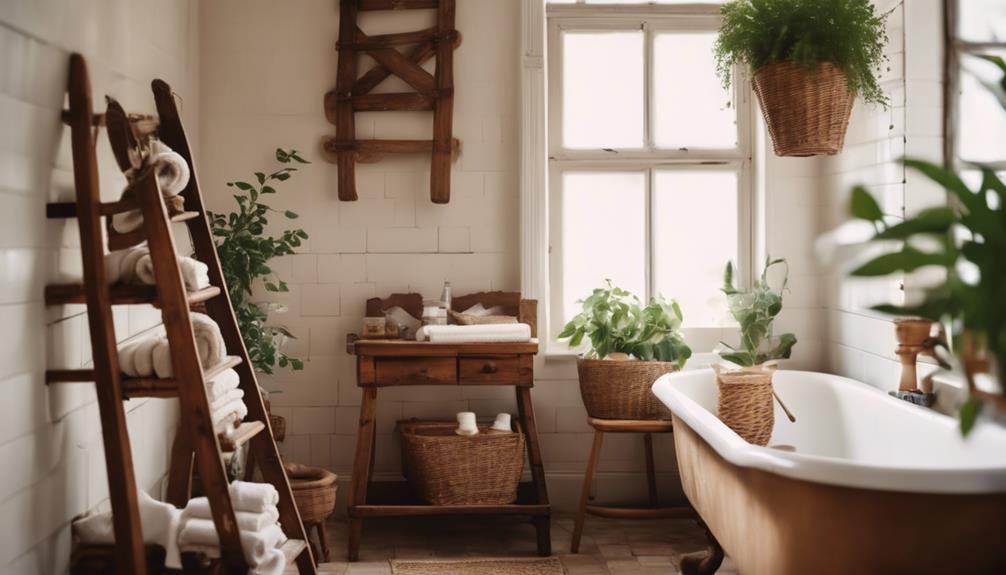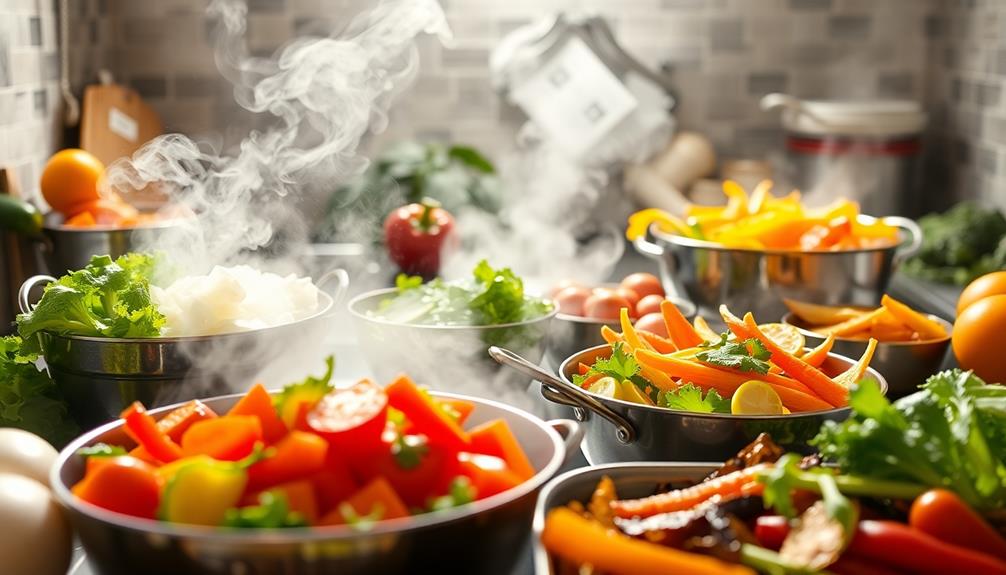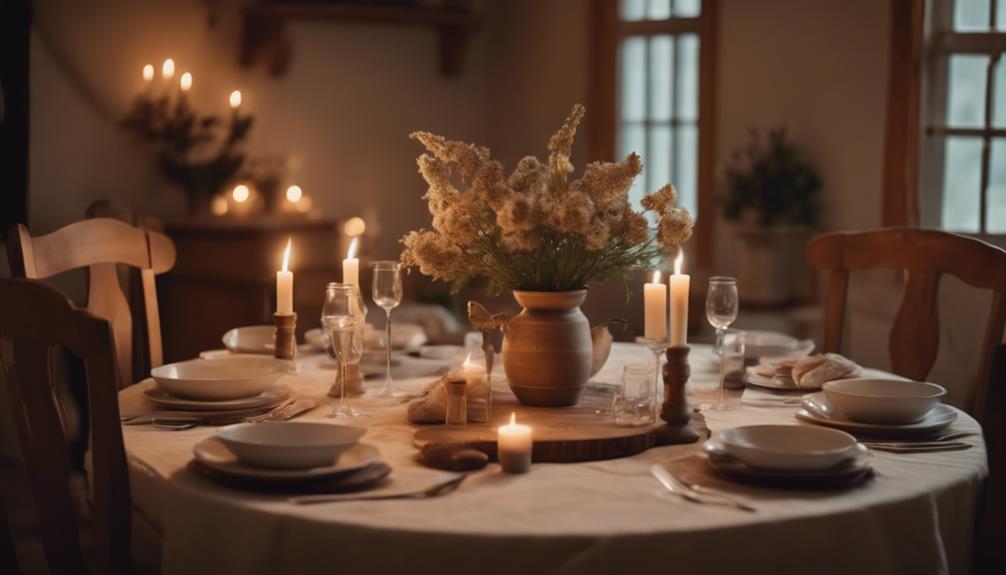You can easily add a touch of rustic charm to your bathroom without undergoing a complete remodel. Begin by creating a cozy, earthy color palette with soft greens and warm browns to establish a welcoming environment. Integrate natural materials such as reclaimed wood for shelves or vintage wooden cabinets to enhance the rural aesthetic. Install a farmhouse sink and antique brass fixtures for a classic look. Utilize rustic lantern-style lighting for a cozy ambiance and incorporate decorative elements like wildflower vases for added character. Lastly, opt for cottage-style tiles or reclaimed barn wood flooring to finish off the design. This will result in a comfortable retreat that exudes the beauty of the countryside. Discover more tips to enhance your space!
Key Elements

When you're ready to infuse country charm into your bathroom, focusing on key elements like color scheme, materials, and textures is essential.
Choosing earthy tones and natural materials creates a warm, inviting space that reflects the countryside.
Let's explore how these elements can transform your bathroom into a charming retreat.
Color Scheme
To achieve a serene and inviting atmosphere in your bathroom, consider an earthy color palette that features beige, cream, soft greens, and warm browns, reflecting the rustic charm of country decor. This color scheme creates a calming environment, ideal for unwinding after a long day.
You can enhance the overall vibe by incorporating accents of terracotta and rust, which add warmth and character without extensive remodeling.
If you want to introduce a hint of cheerfulness, consider adding soft pastels like gentle yellows or light blues. These shades complement floral patterns typical of country-style decor, bringing a touch of whimsy to your space.
By choosing paint colors that mirror the natural hues found in the countryside, you'll create a cohesive look that seamlessly invites the outdoors in.
Additionally, this earthy color scheme aligns beautifully with natural elements such as reclaimed wood and stone. You can easily incorporate these textures through accessories and textiles, further enhancing the country charm of your bathroom.
Materials
Incorporating natural materials like reclaimed wood and stone can instantly elevate your bathroom's country charm, creating a warm and inviting atmosphere. Reclaimed wood works wonders as shelving or accent walls, adding a rustic touch that connects to a countryside aesthetic. For your countertops, consider natural stone options like granite or marble. These materials not only evoke a sense of nature but also guarantee durability and timelessness.
To enhance that cozy, country cottage feel, opt for stone or tile flooring with natural finishes. This choice grounds your space in the beauty of natural elements, making it feel more connected to the outdoors. If you have exposed wooden beams or brick walls, they can introduce inviting visuals that amplify the rustic atmosphere.
Don't forget about storage! Vintage wooden cabinets or wrought iron shelving units offer practical solutions while blending seamlessly into your country style. These materials enhance functionality without sacrificing charm, making your bathroom a perfect retreat.
Textures
Textures play an essential role in enhancing the country charm of your bathroom, inviting warmth and character through thoughtful choices in materials and finishes.
Incorporating reclaimed wood for shelves and cabinetry instantly adds rustic charm and warmth, making your space feel inviting and cozy. You can also consider using textured tiles or sponge-painted walls; these elements introduce visual interest and depth, reflecting the rustic aesthetics typical of country-style design.
Natural fabrics like cotton or linen for towels and curtains enhance comfort while aligning perfectly with the earthy theme. Adding vintage-inspired rugs can provide warmth and texture underfoot, further contributing to the inviting charm of the space.
Don't forget about decorative elements—distressed wood frames for mirrors or wrought iron fixtures introduce authenticity and character, both essential for achieving that rustic feel.
Essential Fixtures and Furniture

To truly embrace country charm in your bathroom, you'll want to focus on essential fixtures and furniture that reflect rustic elegance.
Start with a farmhouse sink for that inviting touch, and pair it with an antique brass faucet to enhance the vintage vibe.
Don't forget a rustic wooden towel rack to add both style and functionality to your space.
Rustic Farmhouse Sink
A rustic farmhouse sink, with its charming apron-front design, instantly elevates your bathroom's functionality and aesthetic appeal. This essential fixture not only offers ample space for washing and cleaning but also serves as a stunning focal point in your rustic-themed space. Made from durable materials like fireclay or stainless steel, a rustic farmhouse sink guarantees a timeless look that complements your decor beautifully.
If you're looking for added practicality, consider a double basin farmhouse sink. It makes managing tasks like washing and rinsing simultaneously a breeze. Pair your farmhouse sink with vintage-style faucets to enhance the country charm, creating a cohesive design that reflects traditional craftsmanship.
To further enhance the rustic feel of your bathroom, add decorative elements around the farmhouse sink. Wooden trays or earthy-toned accessories can create an inviting atmosphere that ties the whole look together. By incorporating a rustic farmhouse sink into your bathroom, you not only invest in a functional piece but also infuse your space with warmth and character. You'll love how it transforms your bathroom into a charming retreat.
Antique Brass Faucet
Adding an antique brass faucet to your rustic bathroom not only enhances the vintage appeal but also pairs beautifully with elements like the farmhouse sink and reclaimed wood accents. The warm tones of an antique brass faucet harmonize with earthy color palettes, creating a cohesive and inviting atmosphere. Its unique patina adds a character that perfectly complements country charm.
When selecting an antique brass faucet, look for options with intricate detailing or a distressed finish to elevate your bathroom's aesthetic. These features evoke a sense of timeless elegance reminiscent of country living, making your space feel more authentic. You'll find various styles available, from farmhouse to vintage designs, ensuring you can find the perfect match for your decor.
Incorporating an antique brass faucet also enhances the perceived value of your bathroom. Potential buyers are often drawn to fixtures that showcase craftsmanship and sophistication, making your home more appealing. By choosing an antique brass faucet, you're not just upgrading a fixture; you're infusing your bathroom with a lasting charm that speaks to both style and functionality.
Rustic Wooden Towel Rack
Incorporating a rustic wooden towel rack not only elevates your bathroom's charm but also promotes sustainability by using reclaimed materials. This choice not only adds character but also helps reduce waste, giving your space an eco-friendly touch. Opt for a design featuring exposed wooden beams or a distressed finish to enhance that rustic aesthetic, creating a warm, inviting atmosphere.
Consider a floating towel rack to maximize your space; it showcases the natural beauty of the wood while keeping your towels accessible. You can also incorporate wrought iron brackets with your rustic wooden towel rack for added durability and style, blending functionality with country aesthetics.
To maintain the wood's beauty and longevity, use natural finishes like oil or wax. These finishes not only protect the wood but also preserve its organic look, reinforcing your connection to nature.
A rustic wooden towel rack serves as both a practical fixture and a decorative element, making it a perfect addition to your country-inspired bathroom. By choosing this charming piece, you'll enhance your bathroom's overall appeal while embracing sustainable living.
Lighting Ideas

When it comes to lighting, you can truly enhance your bathroom's country charm.
Rustic lantern-style fixtures and soft Edison bulb lights create a warm, inviting glow that complements your decor.
Don't forget about charming candle wall sconces or an antique chandelier over the bathtub to add that perfect finishing touch.
Rustic Lantern-Style Fixtures
Rustic lantern-style fixtures bring a charming warmth to your bathroom, enhancing the country aesthetic with their blend of wrought iron and weathered wood.
These fixtures create a cozy atmosphere that welcomes you every time you step inside. You can find rustic lantern-style fixtures in various designs, such as hanging pendant lights and wall sconces, giving you versatile options to suit your space.
When you choose dimmable lantern-style lights, you can easily adjust the brightness to match your mood, whether you want a bright light for morning routines or a soft glow for relaxing baths.
Many of these fixtures emulate vintage styles, often featuring Edison bulbs that add a nostalgic touch and further emphasize that farmhouse feel.
As you select your rustic lantern-style lighting, consider coordinating finishes like antique brass or aged black with other bathroom fixtures.
This thoughtful detail creates a harmonious design that ties the space together beautifully. With the right rustic lantern-style fixtures, your bathroom can transform into a warm, inviting retreat that reflects your love for country charm.
Soft Edison Bulb Fixtures
Soft Edison bulb fixtures instantly infuse your bathroom with a warm, inviting glow that perfectly complements the country charm of your decor. These fixtures, with their vintage-inspired designs, enhance rustic elements like reclaimed wood or wrought iron, creating a cohesive look that feels both nostalgic and welcoming.
Edison bulbs emit a soft, golden light that can soften harsh overhead lighting, transforming your space into a relaxing retreat. This ambiance is ideal for unwinding after a long day or enjoying a soothing bath. By installing dimmer switches alongside your soft Edison bulb fixtures, you can easily adjust the lighting to suit various activities, whether you're waking up in the morning or winding down at night.
Available in styles from pendant lights to wall sconces, soft Edison bulb fixtures can seamlessly blend into your existing decor without the need for a full remodel. Their versatility makes them a practical choice for enhancing your bathroom's country aesthetic, allowing you to create a cozy atmosphere that invites you to linger.
Embrace the charm of soft Edison bulb fixtures, and watch your bathroom transform into a warm, inviting sanctuary.
Charming Candle Wall Sconces
Adding charming candle wall sconces to your bathroom not only enhances the country aesthetic but also provides a warm, inviting glow that complements your existing decor.
Opt for candle wall sconces made from wrought iron or distressed wood to infuse rustic charm and create a cozy atmosphere. Vintage-style sconces with an antique brass finish can further elevate the ambiance, perfectly aligning with earthy color palettes.
Consider incorporating sconces with a lantern design; they evoke a farmhouse feel while offering ambient lighting ideal for a relaxing bath. Strategically placing these candle wall sconces near mirrors or along walls enhances visual interest, especially on feature walls like exposed brick or reclaimed wood.
Don't forget to use scented candles in your sconces! Not only will they illuminate your space, but they'll also fill your bathroom with delightful fragrances, transforming your daily routine into a soothing experience.
Whether you choose simple designs or more elaborate ones, these candle wall sconces are a practical and stylish way to bring country charm into your bathroom without the need for a full remodel.
Antique Chandelier Over Bathtub
How about hanging an antique chandelier over your bathtub to create a striking focal point that elevates the country charm in your bathroom? An antique chandelier can add a unique vintage touch while enhancing the rustic ambiance. Opt for one made from wrought iron or wood to perfectly harmonize with your country theme, providing that charming, old-world appeal.
When selecting your chandelier, be certain to choose a model rated for bathroom use. This guarantees safety and durability in a moisture-rich environment. Incorporating dimmable bulbs can further enhance the experience, allowing you to set the mood for a relaxing soak or brightening things up when needed.
To create a cohesive lighting design, consider pairing the antique chandelier with vintage-inspired sconces on either side of the mirror. This not only enhances the overall rustic aesthetic but also guarantees you have ample lighting for daily tasks.
With the right antique chandelier, you'll transform your bathroom into a charming sanctuary, making it a delightful space to unwind after a long day. Embrace the beauty of vintage elegance and let your bathtub shine!
Decorative Elements

To truly embrace country charm in your bathroom, focus on decorative elements that bring warmth and personality.
A wildflower vase centerpiece can brighten up your space, while handcrafted wooden wall art adds a rustic touch.
Don't forget a vintage ceramic soap dish to complete the look with a hint of nostalgia.
Wildflower Vase Centerpiece
Why not bring the beauty of the outdoors into your bathroom with a wildflower vase centerpiece that captures the essence of country charm? A wildflower vase can instantly enhance the rustic charm of your space, whether you choose fresh blooms or dried arrangements.
Opt for vintage or mason jars as vases to evoke a farmhouse aesthetic, turning your centerpiece into an inviting focal point. Incorporating seasonal wildflowers like daisies or lavender adds a vibrant pop of color and delightful fragrance, elevating the natural ambiance of your bathroom.
Don't hesitate to mix in wild grasses or branches to create a more dynamic arrangement that embodies true country style. This not only adds texture but also a sense of organic beauty.
Place your wildflower vase on open shelving or a reclaimed wood countertop to keep it accessible while showcasing its visual appeal. This functional decorative element will breathe new life into your bathroom and remind you of the beauty of nature every day.
With just a simple arrangement, you can effortlessly infuse your space with country charm that feels warm and inviting.
Handcrafted Wooden Wall Art
Transforming your bathroom into a cozy retreat is easy with handcrafted wooden wall art that adds a touch of country charm and personality.
Consider incorporating reclaimed wood signs or rustic frames to enhance the aesthetic. These pieces, especially those with natural finishes or distressed paint, evoke a vintage vibe that creates a warm and inviting atmosphere.
Unique designs, such as nature-inspired motifs or charming farmhouse quotes, not only serve as focal points but also reflect your personal style. By selecting handcrafted wooden wall art, you support local artisans, promoting sustainable practices while ensuring authenticity in your decor.
Don't shy away from varying the sizes and arrangements of your wall art. This approach creates visual interest and depth, making your bathroom feel more cohesive with its rustic charm. A well-placed piece can transform a blank wall into a statement that captures attention.
Vintage Ceramic Soap Dish
A vintage ceramic soap dish brings character and nostalgia to your bathroom, effortlessly enhancing its rustic charm. These charming accent pieces can serve as focal points, drawing the eye and adding warmth to your space. When you opt for a soap dish in earthy tones or floral patterns, it seamlessly blends with a country aesthetic, creating a cohesive look.
What truly sets vintage ceramic soap dishes apart are their unique hand-painted designs and distressed finishes. Each piece is one-of-a-kind, adding a layer of vintage charm that mass-produced items simply can't replicate. Incorporating one not only elevates your bathroom's visual appeal but also encourages the use of traditional bar soaps, perfectly aligning with a rustic lifestyle.
Consider displaying your vintage ceramic soap dish on open shelving or a rustic countertop. This choice not only showcases the dish but also enhances the overall ambiance of your bathroom. By embracing such decorative elements, you can infuse your space with a sense of nostalgia and character, transforming it into a charming retreat that feels like home.
Flooring

When it comes to flooring, you've got some fantastic options to choose from.
Reclaimed barn wood planks can add a warm, rustic touch, while cottage-style tile flooring brings a classic charm.
Textured stone pavers also offer durability and visual interest, helping to create that cozy country feel you're after.
Reclaimed Barn Wood Planks
Reclaimed barn wood planks bring rustic charm and sustainability to your bathroom flooring, turning reclaimed materials into a stunning focal point. These planks not only enhance the aesthetic appeal with their unique variations in color and texture but also contribute to an eco-friendly lifestyle by repurposing wood that might otherwise go to waste.
You'll find that reclaimed barn wood flooring is typically more durable than new wood, as the aging process strengthens the planks. This added durability means they're less susceptible to warping and moisture damage, making them an ideal choice for a bathroom environment.
Plus, they can improve insulation, providing better temperature regulation, which is especially beneficial in colder climates.
To keep your reclaimed barn wood planks looking their best, applying a protective sealant is essential. This sealant will withstand moisture while preserving the wood's natural beauty.
Cottage-Style Tile Flooring
Cottage-style tile flooring offers a perfect complement to the warmth of reclaimed barn wood planks, enhancing your bathroom's rustic charm with natural textures and earthy tones.
Opt for natural stone or earthy-toned ceramic tiles that evoke a countryside feel. Patterns like hexagons, subway tiles, or herringbone layouts add visual interest and a vintage touch, making your space feel cozy and inviting.
For an authentic rustic look, choose tiles with a matte finish instead of glossy surfaces. This subtle difference creates a more genuine connection to the cottage aesthetic. You can further enhance the rustic charm by incorporating natural elements in your tile choices, such as pebble or slate textures, which bring the outdoors inside.
To maintain a cohesive theme, select tiles in soft, earthy colors like beige, soft greens, or warm browns. These hues harmonize beautifully with other elements in your bathroom, creating a serene and inviting atmosphere.
Textured Stone Pavers
Textured stone pavers, like slate and limestone, bring a durable and natural appeal to your bathroom while effortlessly enhancing its rustic charm. These flooring options not only look stunning but also offer practical benefits. The varied textures and colors of textured stone pavers create visual interest and complement elements such as reclaimed wood and exposed brick, giving your space a cohesive feel.
In addition to their aesthetic qualities, textured stone pavers are slip-resistant, making them a smart choice for wet bathroom environments. You can walk with confidence knowing you've chosen a stylish yet practical flooring solution.
For added comfort during colder months, consider incorporating heated stone flooring, which helps maintain a cozy atmosphere that perfectly aligns with your country theme.
Moreover, the natural porosity of stone pavers allows for breathability, aiding in humidity regulation. This feature contributes to a healthier indoor environment, ensuring that your bathroom remains fresh and comfortable.
Can I Achieve a Luxury Spa Style in My Bathroom Without a Remodel?
Yes, you can transform your bathroom into luxury spa without a remodel. Simple changes like adding plush towels, soothing candles, and a chic vanity can create a spa-like ambiance. Incorporating calming colors and natural elements can also elevate the overall atmosphere, allowing you to achieve a luxury spa style at home.
Conclusion
By incorporating key elements like rustic fixtures and charming decor, you can easily infuse country charm into your bathroom without the hassle of a remodel.
Focus on essential furniture, warm lighting, and decorative accents that reflect the countryside vibe.
Don't forget to choose flooring that complements the overall aesthetic.
With these simple changes, your bathroom will feel inviting and cozy, making it a perfect retreat that captures the essence of country living.









